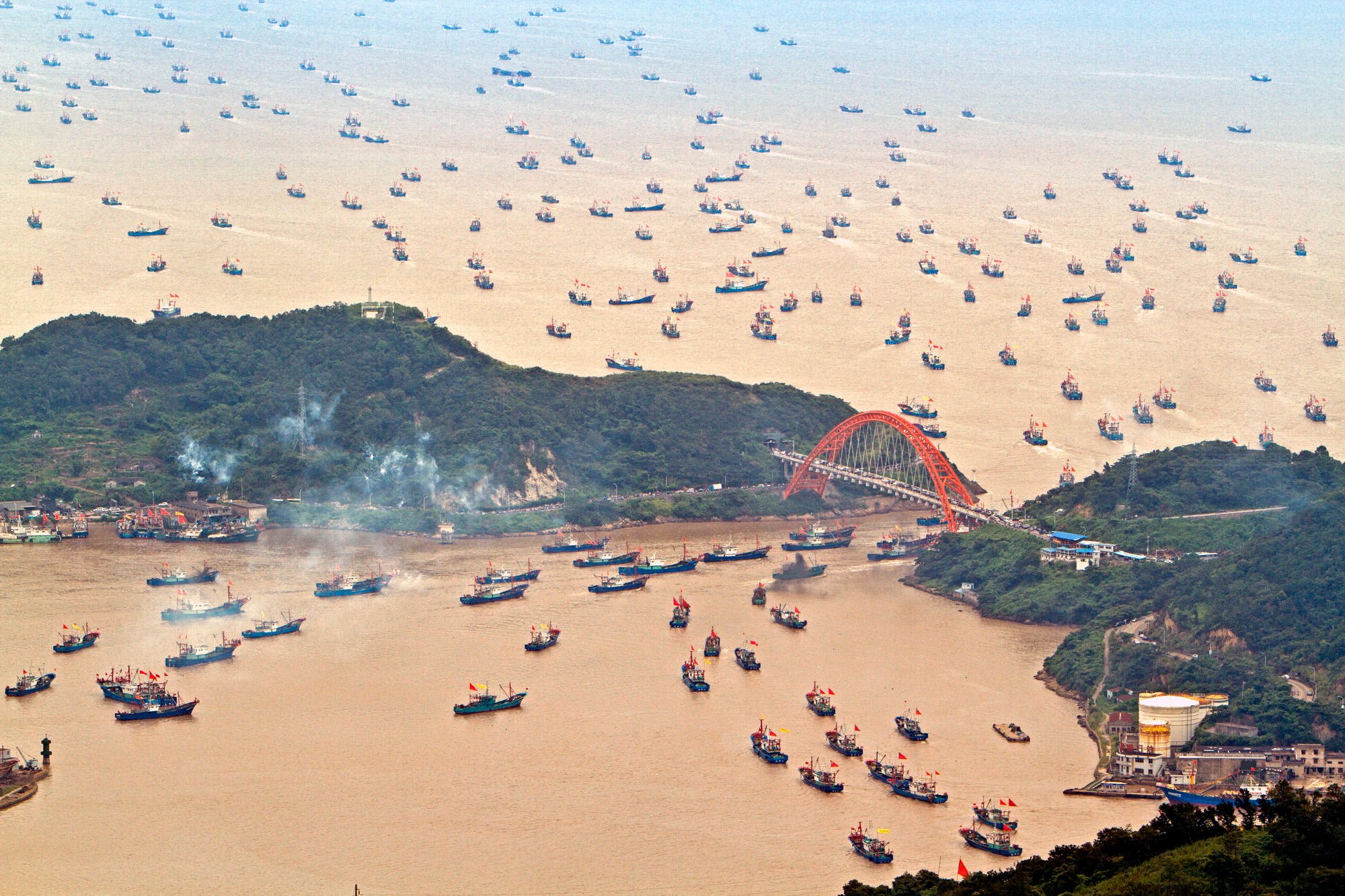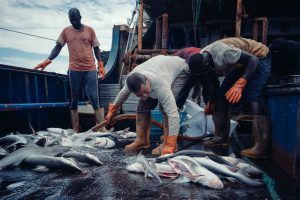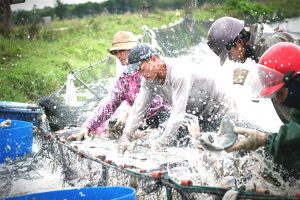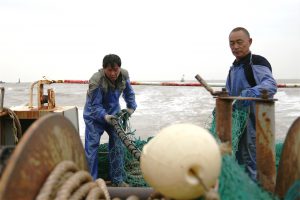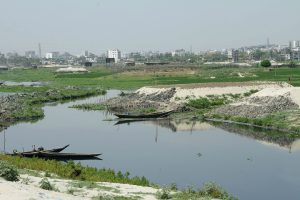Whether it’s to work in tourism or to run a cold store, more and more fishermen in China are returning to dry land. After decades of overfishing, most don’t have a choice.
China’s coastal waters used to provide rich fishing grounds, but those days have long since passed, and with them many of the jobs. In Xiangshan, once a prosperous fishing town in the south-eastern province of Zhejiang, almost 400 fishing vessels out of about 3000 will need to be scrapped by 2019.
The crisis affecting China’s coastal fisheries has become impossible to ignore. In December 2016, the Ministry of Agriculture published its toughest plan yet to reduce the annual catch size by almost a quarter within three years; from over 13 million tonnes a year to under 10 million. (The ministry calculates that a sustainable catch is 8-10 million tonnes a year.)
China barely ranked as a fishing nation 30 years ago, but it is now the world’s largest producer and consumer of seafood products. Yet the rapid growth in coastal fishing, and the pressure this has put on fish stocks, has proved the adage expressed by Britain’s chief fisheries scientist Michael Graham, who in 1943 declared that, “fisheries that are unlimited become unprofitable”.
Early limits
The boom in China’s coastal fishing dates back to Deng Xiaoping’s economic reforms in the late 1970s.
Prior to China adopting market mechanisms, the country’s fishing sector was governed according to central government strategy. In the 1960s, fishing boats were limited in number and made of wood. They belonged to village communes, which decided where and when the boats fished. Individuals were not permitted to invest.
China’s ossified commune system effectively limited the amount of fish caught. Despite widespread food shortages, China’s coastal fishing catch by the mid-1970s was only three million tonnes, according to data from the United Nations Food and Agriculture Organisation (FAO).
China starts overfishing
In a review of China’s fishing policy, Cao Ling, a researcher at Stanford University’s Centre on Food Security and the Environment, traced the turning point for the industry to the Fisheries Law of 1986.
The Fisheries Law called for the rapid development of fishing in Chinese waters through the privatisation of fishing vessels and growth of seafood markets.
It declared: “The state shall encourage and support the development of offshore and deep sea fisheries and make rational arrangements for fishing capacity for inland and inshore fisheries”.
Data from the Ministry of Agriculture and compiled by Greenpeace show the catch size increased almost 200% between 1986 and 1995.
The reforms were effective but overfishing meant the good times did not last. By 1999, additional fishing capacity was failing to deliver an increase in overall catch, which plateaued at around 12 million tonnes a year. In other words, China’s coastal fleet was having to expend more effort just to maintain its existing catch level.
According to Cao Ling’s review, the quality and value of China’s catch has plummeted, too. Overfishing of large commercial species, such as yellow croaker and large head hairtail, which used to be the bulk of the catch, has led to their decline. Nowadays, 80% of the catch is composed of small, low-value fish, such as anchovy and mackerel. In fact, one third of the catch is not deemed sufficiently nutritious for human consumption so is used to produce fodder, according to Greenpeace.
80%
The catch from China's coastal fisheries that is comprised of small, low-value fish
Investing more resources to maintain output is not a sustainable way to deliver long-term food security.
China has 20% of the world’s population but only 7% of its arable land. The pressure to produce food had led it to become the biggest maker and user of pesticides and fertiliser. But fishing isn’t like farming. More investment in fishing has not led to more fish in the sea, but instead to many species being overfished.
Regulating coastal fisheries
By 1995, a decade after the State Council document encouraging privatisation of fishing, China’s catch passed the 10 million tonnes a year mark, marking a turning point in the sustainability of the coastal fisheries, as calculated by the Ministry of Agriculture.
As China’s coastal catch reached that critical point, the government realised the risk of over-exploitation and put in measures from the mid-90s that form the current system of coastal fisheries management. These include:
- Summer closures
Since 1995, fisheries in the Bohai, Yellow and East China seas are closed during the summer to allow fish populations respite to breed and grow. A summer closure has been in effect in the South China Sea since 1999.

In recent years, the summer closures have been extended. Until 2017 they ran for two or three months above a latitude of 12° from June 15 or July 1 to mid-September, with variations according to the location and type of fishing. From 2017, China has ended fishing from May 1, meaning a closure of four and half months in some places.
When do China’s coastal fisheries reopen after the summer closure?
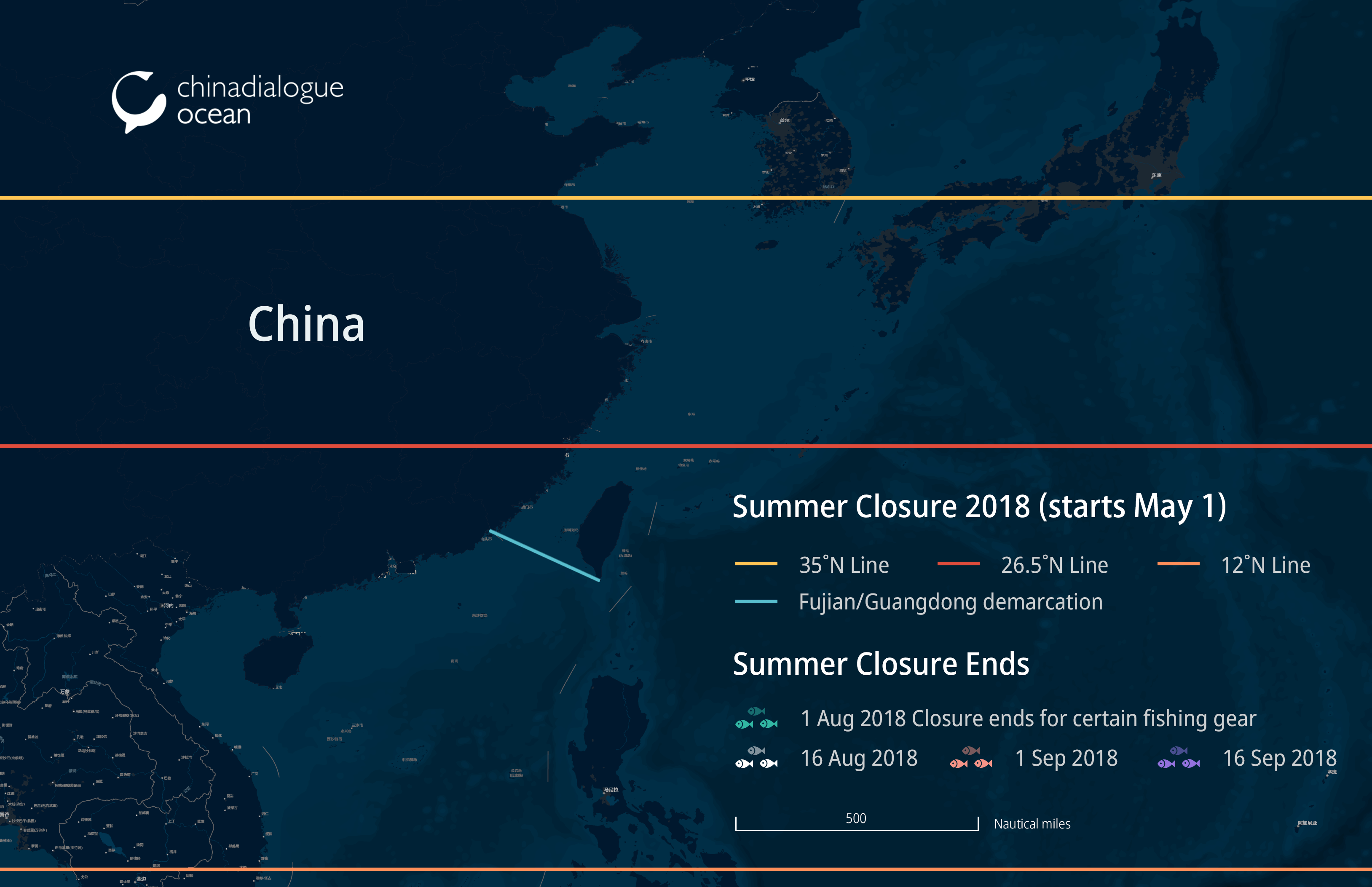
- Gear regulation
Rules banning damaging fishing methods such as the use of explosives, poison or electrocution, date back to 1979 but were toughened up in 2013 by the Ministry of Agriculture. Rules on net sizes came into force on June 1, 2014, in the Yellow and Bohai seas, the East China Sea and the South China Sea. Three types of fishing gear that cause damage, including some types of trawling, were also banned.
- Vessel management
China started to exert control over the number of fishing vessels and their engine power in 1987. The number of old and wooden vessels was reduced. The import of fishing vessels for use in Chinese waters was banned. Fishing industry law and regulations require vessels to have test certificates, registration documents and a fishing license. A document issued by the Ministry of Agriculture in 2000 called for “negative growth” in the fishing industry.
In 2002 China started controlling inputs to the industry, with scrappage and buyback schemes offering subsidies to persuade fishermen to give up older boats. In 2003 a policy of encouraging fishermen to change career came into effect.
Unfortunately, efforts to regulate coastal fishing have been undermined by China’s fuel subsidies, which began in 2006 across a number of sectors, including agriculture and fishing. Fishing vessels receive subsidies based on their engine size and fuel use.
The fishing industry’s fuel subsidy originated to protect vulnerable groups during fuel price reforms, said Professor Wang Yamin of Shandong University’s Marine College. Highway maintenance fees were folded into fuel prices, so fishing vessels got a subsidy to compensate them for the additional cost. Unfortunately, the subsidies, which have continually increased in the ten years since launch, had unintended consequences.
Some fishing vessels are now reliant on them, which accounts for the larger part of their income. One-off subsidies for scrapping a vessel can’t compete with the fuel subsidy, which can easily be worth tens of thousands of yuan annually. Fuel accounts for the major part of costs in the fishing industry, and the subsidy has allowed the sector to continue expanding.
Will ‘ecological civilisation’ stop China overfishing?
But that expansion may be halted if the concept of an ecological civilisation, can spread from land-based action to the ocean. If Deng Xiaoping made economic development the focus for all of China, then Xi Jinping is attempting to do the same for the environment.
Constructing an ecological civilisation has even shaken up the long-standing fuel subsidy policy. In 2015, the ministries of finance and agriculture admitted that the large and sustained subsidies paid since 2006 had distorted price signals and were inconsistent with policies to reduce the vessel numbers and transition fishermen into other jobs.
The central government announced that the subsidy will be cut annually, with the aim of bringing payments down to 40% of the 2014 subsidy level by 2019. This reduction in subsidy is expected to push fishermen (which number between one and four million) to quit the industry.
China is also looking for breakthroughs in fishing technology and working towards a more scientific and detailed management system. In 2014 Zhejiang, a major fishing province, issued China’s first provincial standard on the size of fish caught and the proportion of young fish in catches, setting a minimum size for 18 species of fish. Zhejiang and Shandong are also experimenting with catch quotas for horse crab and flame jellyfish, respectively.
The 13th Five-Year Plan for the fishing industry states that each of China’s 11 coastal provinces must have at least one trial of catch quotas by 2020. It may be a little late, but these initiatives will gather valuable data to be used in the implementation of a “fishing quota system”, mentioned in the 2000 revision of the Fisheries Law.
The sustainability of China’s coastal fisheries has an impact on the global footprint of the country’s distant water fleets. Overfishing in coastal areas has spurred rapid growth in fishing from more distant waters. China has the world’s largest distant water fishing fleet, of 2,600 vessels. If coastal overfishing can be resolved then work can be found nearer home for the fishing sector’s excess capacity.
So what lesson has been learned from these last 30 years? Perhaps that overly-broad and unenforced policies cannot prevent overfishing in China’s coastal waters. Talk is easier than action; China must do everything it has said it wants to do if the situation is to be turned around.
The author thanks Liu Lijun for contributions to research for this article.
